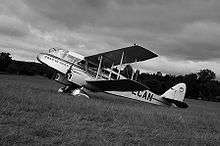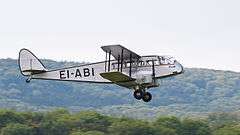de Havilland Dragon
| DH.84 Dragon | |
|---|---|
 | |
| Role | Passenger and military transport / trainer |
| Manufacturer | de Havilland |
| First flight | 12 November 1932 |
| Introduction | April 1933 |
| Number built | 202 |
|
| |
The de Havilland DH.84 Dragon was a successful small commercial aircraft designed and built by the de Havilland company.
Design and construction
Following the commercial success of its single-engined de Havilland Fox Moth that had first flown in March 1932, that aircraft's original commercial operator Hillman's Airways requested that a larger twin-engined version be built. It was a simple, light design with a plywood box fuselage using the same type of engine and similar outer wing sections of the earlier single-engined aircraft. It was originally designated the DH.84 "Dragon Moth" but marketed as the "Dragon". The prototype first flew at Stag Lane Aerodrome on 12 November 1932, it and the next four aircraft were delivered to Hillman's which started a commercial service in April 1933. It could carry six passengers, each with 45 lb (20 kg) of luggage on the London-Paris route on a fuel consumption of just 13 gal (49 l) per hour. The wing panels outboard of the engines could be folded for storage.[1]
Operational service

The Dragon proved very attractive as a short-haul low capacity airliner and was soon in service worldwide. From the 63rd aircraft late in 1933, the Dragon 2, with improvements including individually framed windows and faired undercarriage struts, was produced. Even though these changes were largely cosmetic the streamlining improved the aircraft's speed by about 5 mph (8 km/h), allowed 250 lb (113 kg) more payload to be carried and added 85 mi (137 km) of range.
British production of the DH.84 ended at the 115th aircraft, when it was replaced on the assembly line by the more powerful and elegant DH.89 de Havilland Dragon Rapide. However, during the Second World War, the DH.84 was put back into production at Bankstown, Australia as a navigational trainer for the Royal Australian Air Force, being preferred to the Rapide because its smaller engines were then being manufactured locally for de Havilland Tiger Moth production. A further 87 were built, for a total of 202 produced.
A new four-seat Dragon was delivered in 1933 to the Royal Flight for use by the Prince of Wales. It was sold in 1935. It was later pressed into service by the Royal Australian Air Force during the Second World War.
A special aircraft named Seafarer was built for Amy Johnson (a pioneering English aviator) and her husband Jim Mollison (a famous Scottish pioneer aviator) to make an attempt at the world long distance record. It had a strengthened landing gear and the cabin had extra fuel tanks. It was intended to fly from New York to Baghdad, Iraq, but at their first attempt at a transatlantic flight from Croydon Airport in South London to the United States on 8 June 1933 the landing gear collapsed. After repairs Seafarer left Pendine Sands in South Wales and arrived at Bridgeport, Connecticut in the United States 39 hours later. However, on landing the aircraft turned over and was damaged.[2]
The engines and fuel tanks were recovered from Seafarer and used in another Dragon named Seafarer II. After three attempts to take off from Wasaga Beach, Ontario, Canada for Baghdad, Iraq, the attempt was abandoned and the aircraft was sold. On 8 August 1934, the new owners, James Ayling and Leonard Reid, took off in the Dragon, renamed Trail of the Caribou, from Wasaga Beach in another attempt at the distance record. Although the intended target was Baghdad, throttle problems forced the attempt to be abandoned, and Trail of the Caribou landed at Heston Aerodrome, an airfield west of London, in Middlesex, UK after 30 hours 55 minutes, making the first non-stop flight between the Canadian mainland and Britain.[3][4]
The inaugural service of the Irish Airline Aer Lingus was provided by a DH.84 Dragon, registration EI-ABI and named Iolar, which means "Eagle" in the Irish language. For the 50th anniversary of the airline in 1986, a replacement Dragon was acquired, restored, reregistered as EI-ABI and repainted as the Iolar.
Following the War, surviving DH.84s passed into commercial service, but only three are still flying today.
Accidents and incidents
- On the morning of Thursday, 21 February 1935, two sisters, Jane and Elizabeth Du Bois, daughters of the American Consul in Naples, jumped from a Hillman Airways de Havilland Dragon en route from Essex Airport to Paris. The double suicide was attributed to the recent deaths of the young women’s alleged fiancés, two R.A.F. pilots who had been killed in a flying boat accident near Messina, Italy.[5]
- On 1 July 1935, G-ADED of Railway Air Services crashed on take-off from Ronaldsway Airport, Isle of Man injuring all seven people on board. The aircraft, which was operating a scheduled passenger flight from Ronaldsway to Ringway Airport, Manchester, Lancashire via Squires Gate Airport, Blackpool and Speke Airport, Liverpool, was destroyed in the subsequent fire.[6]
- On 26 March 1936, G-ACAP of Commercial Air Hire crashed near Lyndhurst, Hampshire, England killing all five on board. The aircraft had flown from Croydon Airport and was carrying out military cooperation work around Southampton. Commercial Air Hire had a contract to fly at night to give searchlight crews practice at locating aircraft.[7]

- 1 October 2012 - 2012 Riama crash. A privately owned 1934 de Havilland DH.84 Dragon 2 registration VH-UXG, named Riama (pictured) went missing in bad weather returning from an air show near Monto, Queensland, Australia to Caboolture.[8] Queensland Police found the wreckage near Borumba Dam. All six occupants were killed and the aircraft destroyed after impacting a ridge.[9] The pilot and owner had flown into unexpected thick cloud and issued a securite call. The aircraft's only primary instruments were an airspeed indicator and altimeter. All six occupants died.
Variants
- Dragon 1 : Twin-engined medium transport biplane.
- Dragon 2 : Improved version. Fitted with framed cabin windows and two faired main undercarriage legs.
- DH.84M Dragon : Military transport version. The DH.84M was armed with two machine guns, and it could carry up to sixteen 20 lb (9 kg) bombs. Exported to Denmark, Iraq and Portugal.
Operators
♠ Original operators
Military operators
- Royal Danish Air Force♠ - Two DH.84 Dragons
- Royal Iraqi Air Force♠ - Eight DH.84M Dragons
- Portuguese Air Force♠ - Three DH.84 Dragons
- Royal Air Force - Seventeen aircraft impressed.[11]
- Anti-Aircraft Co-operation Units.[11]
- No. 24 Squadron RAF.[11]
- King's Flight ♠
- Yugoslav Royal Air Force - One aircraft was impressed into military service in April 1940.
Civil Operators
- MacRobertson-Miller Aviation
- Western Australian Airways ♠
- Butler Air Transport
- VASP♠
- Misrair
- Lignes Aériennes Nord-Africaines (L.A.N.A.)

- Wilson Airways ♠
- Air Travel (NZ) Ltd
- East Coast Airways ♠
- Union Airways of N.Z. Ltd
- African Air Transport ♠
- Aberdeen Airways ♠
- Air Cruises ♠

- Air Navigation & Trading
- Air Dispatch
- Allied Airways
- Blackpool and West Coast Air Services ♠
- British Airways
- British Continental Airways
- Commercial Air Hire ♠
- Great Western & Southern Air Lines
- Highland Airways ♠
- Hillman's Airways♠
- Jersey Airways ♠
- Midland and Scottish Air Ferries ♠
- Northern and Scottish Airlines
- Olley Air Service ♠
- Provincial Airways
- Railway Air Services ♠
- Scottish Motor Traction ♠
- Spartan Airlines
- Western Airways ♠
- Valsts Gaisa Satiksme - One aircraft was used as a civilian transport.
Specifications (DH.84 Dragon 1)
Data from de Havilland Aircraft since 1909 [12]
General characteristics
- Crew: one, pilot
- Capacity: 6-10 passengers
- Length: 34 ft 6 in (10.52 m)
- Wingspan: 47 ft 4 in (14.43 m)
- Height: 10 ft 1 in (3.07 m)
- Wing area: 376 ft² (34.9 m²)
- Empty weight: 2,300 lb (1,045 kg)
- Loaded weight: 4,200 lb (1,909 kg)
- Powerplant: 2 × de Havilland Gipsy Major 1 4-cylinder air-cooled inverted inline, 130 hp (97 kW) each
Performance
- Maximum speed: 128 mph (111 knots, 206 km/h)
- Cruise speed: 109 mph (95 knots, 167 km/h)
- Range: 460 mi (400 nmi, 740 km)
- Service ceiling: 12,500 ft (3,800 m)
- Rate of climb: 612 ft/min (3.1 m/s)
See also
- Related development
- Related lists
References
| Wikimedia Commons has media related to de Havilland Dragon. |
- ↑ Jackson 1973, p. 122
- ↑ Riding Aeroplane Monthly June 1980, pp. 285–286.
- ↑ Riding Aeroplane Monthly June 1980, p. 289.
- ↑ Lewis 1971, p. 265.
- ↑ Terry Carter, "Jane and Elizabeth Du Bois – an American tragedy in Essex," Loughton and District Historical Society Newsletter 189 (March/April 2011): 5–6.
- ↑ Poole 1999, pp. 12-13.
- ↑ "Air Crash In The New Forest." Times [London, England] 27 Mar. 1936: 14. The Times Digital Archive. Web. 4 Oct. 201
- ↑ Up to 15 helicopters search for missing DH84 Dragon The Australian - October 02, 2012
- ↑ Police locate vintage plane crash site - Australian Broadcasting Corporation - Retrieved 3 October 2012.
- ↑ "Spanish Civil War Aircraft". Retrieved 2012-04-14.
- 1 2 3 Hooks 2011, pp. 42-48.
- ↑ Jackson 1987, p.334.
- Bibliography
- Hooks, Mike. "Civvies at War". Aeroplane. No. October 2011. Cudham: Kelsey Publishing Group.
- Jackson, A.J. (1987). De Havilland Aircraft since 1909 (Third ed.). London: Putnam. ISBN 0-85177-802-X.
- Jackson, A.J. (1988). British Civil Aircraft 1919-1972: Volume II (1988 ed.). London: Putnam (Conway Maritime Press). ISBN 0-85177-813-5.
- Jackson, A.J. (1973). British Civil Aircraft since 1919 Volume 2. London: Putnam. p. 382. ISBN 0-370-10010-7.
- Lewis, Peter (1971). British Racing and Record-Breaking Aircraft. London: Putnam. ISBN 0-370-00067-6.
- Poole, Stephen (1999). Rough Landing or Fatal Flight. Douglas: Amulree Publications. ISBN 1-901508-03-X.
- Riding, Richard (June 1980). "The Black Dragons". Aeroplane Monthly. Vol. 8 no. 6. pp. 284–290. ISSN 0143-7240.